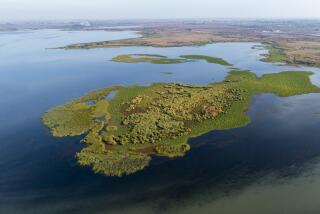CALABASAS : Trip an Immersion in State Water Issues
- Share via
The trip is being paid for by a public agency, and there will be some government officials along, but it can hardly be classified as a junket. Not when the transportation is by bus and the destination is not a fancy resort, but the Colorado River Aqueduct.
“It’s not a party by any stretch,” said Jay Malinowski,, a spokesman for the Metropolitan Water District. The entire trip, he said, will cost the agency $2,500.
Guests will stay at Gene Village, a guest lodge that was created as a tent city for aqueduct workers in the 1930s and which has become the MWD’s field headquarters. “Because space is limited, it will be necessary for you to share a room,” an MWD brochure warns tour participants.
However, the tour is a must for those who want to learn about the problems and costs associated with importing water hundreds of miles across the desert to Southern California, MWD officials say. And many who make the trip come away awed by the size and scope of the aqueduct.
“The reaction from people is fascinating,” said Glen Peterson, a member of the board of directors of the Las Virgenes Municipal Water District, a Calabasas-based water agency that gets its water from the MWD. “A lot of people have no idea about what’s involved, and after they go, they came back very, very knowledgeable.”
Peterson, who also sits on the MWD’s board of directors, is leading an upcoming tour Saturday through Monday. The trip, he said, is a crash course about water issues. “There is very, very little time off,” said Peterson. “You spend 90% of the time in a bus, or in a classroom.”
A group of about 36 people will assemble on Saturday at 6:30 a.m. at the water district office in Calabasas, according to the trip itinerary. The tour will stop at Domenigoni Valley Reservoir Project, near Hemet, a $1.8-billion storage facility under construction that is slated to be the largest reservoir in Southern California.
The tour will continue east, where the group will spend the night at Gene Village near the Colorado River. The following morning, after a 6:30 a.m. breakfast, the bus will depart for a whirlwind tour of the Colorado River Aqueduct System. The bus returns about 5:15 p.m. Monday to the district office.
The 50-year-old aqueduct, which is 242 miles long, has five large pumping plants that lift the water a total of 2,000 feet through mountains from Lake Havasu to the last pumping plant near Palm Springs, said Malinowski. From that point the water flows by gravity throughout the Southern California service area.
The aqueduct annually is capable of pumping 1.2 million acre-feet, or 400 billion gallons, enough to meet the needs of almost 2.5 million people, said Malinowski. The system today would cost about $5.5 billion to build.
More to Read
Sign up for The Wild
We’ll help you find the best places to hike, bike and run, as well as the perfect silent spots for meditation and yoga.
You may occasionally receive promotional content from the Los Angeles Times.






